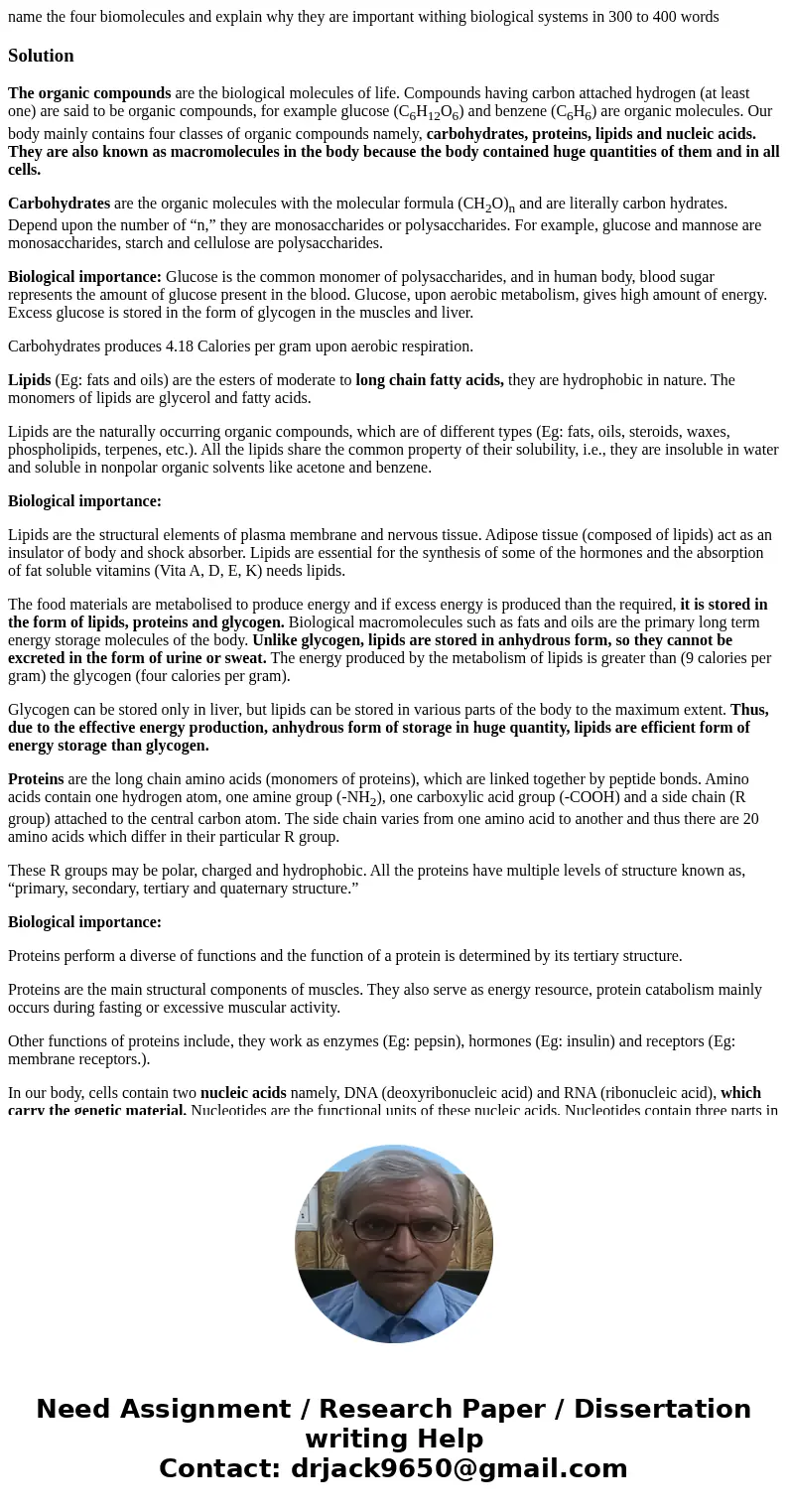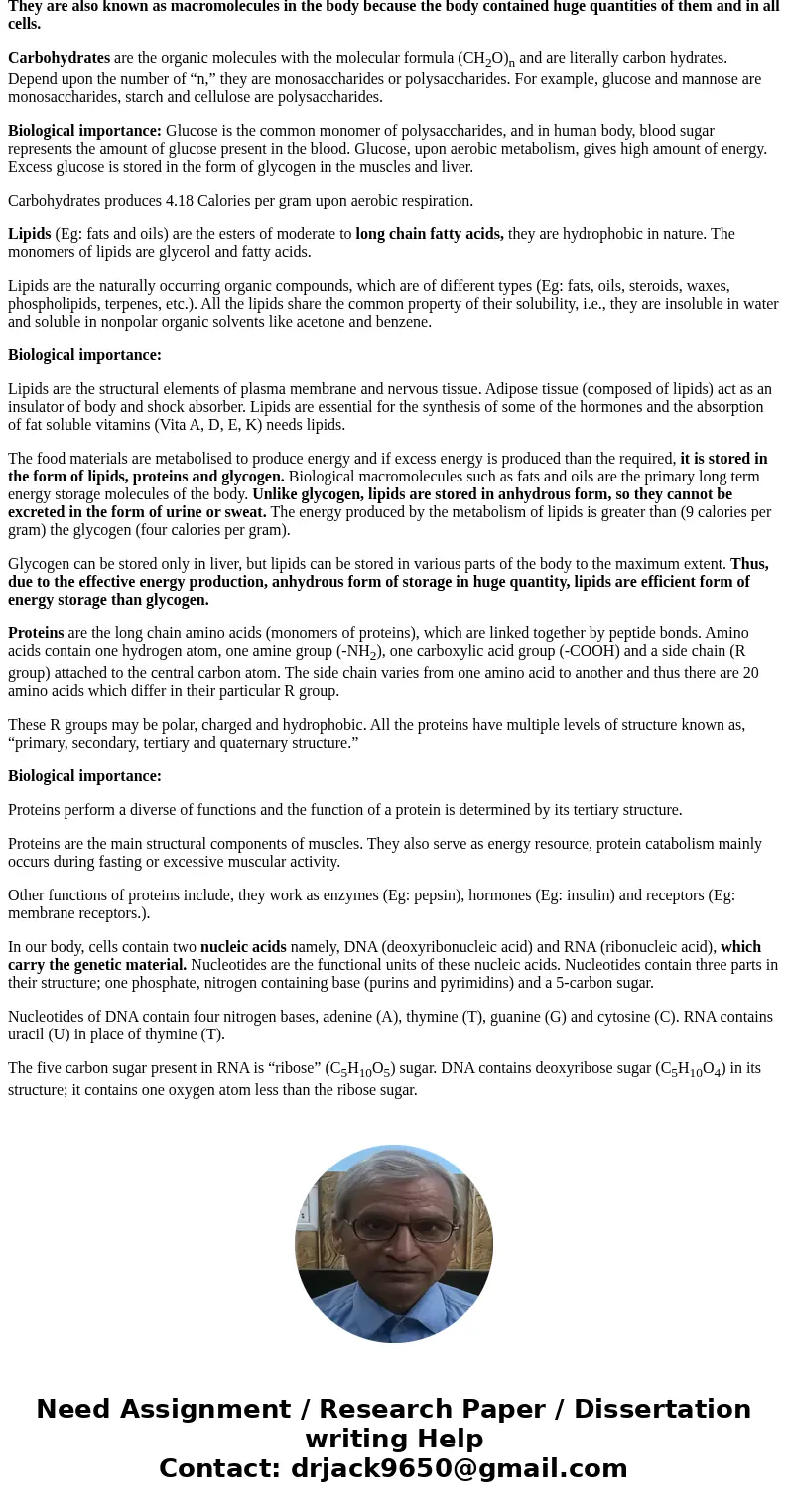name the four biomolecules and explain why they are importan
name the four biomolecules and explain why they are important withing biological systems in 300 to 400 words
Solution
The organic compounds are the biological molecules of life. Compounds having carbon attached hydrogen (at least one) are said to be organic compounds, for example glucose (C6H12O6) and benzene (C6H6) are organic molecules. Our body mainly contains four classes of organic compounds namely, carbohydrates, proteins, lipids and nucleic acids. They are also known as macromolecules in the body because the body contained huge quantities of them and in all cells.
Carbohydrates are the organic molecules with the molecular formula (CH2O)n and are literally carbon hydrates. Depend upon the number of “n,” they are monosaccharides or polysaccharides. For example, glucose and mannose are monosaccharides, starch and cellulose are polysaccharides.
Biological importance: Glucose is the common monomer of polysaccharides, and in human body, blood sugar represents the amount of glucose present in the blood. Glucose, upon aerobic metabolism, gives high amount of energy. Excess glucose is stored in the form of glycogen in the muscles and liver.
Carbohydrates produces 4.18 Calories per gram upon aerobic respiration.
Lipids (Eg: fats and oils) are the esters of moderate to long chain fatty acids, they are hydrophobic in nature. The monomers of lipids are glycerol and fatty acids.
Lipids are the naturally occurring organic compounds, which are of different types (Eg: fats, oils, steroids, waxes, phospholipids, terpenes, etc.). All the lipids share the common property of their solubility, i.e., they are insoluble in water and soluble in nonpolar organic solvents like acetone and benzene.
Biological importance:
Lipids are the structural elements of plasma membrane and nervous tissue. Adipose tissue (composed of lipids) act as an insulator of body and shock absorber. Lipids are essential for the synthesis of some of the hormones and the absorption of fat soluble vitamins (Vita A, D, E, K) needs lipids.
The food materials are metabolised to produce energy and if excess energy is produced than the required, it is stored in the form of lipids, proteins and glycogen. Biological macromolecules such as fats and oils are the primary long term energy storage molecules of the body. Unlike glycogen, lipids are stored in anhydrous form, so they cannot be excreted in the form of urine or sweat. The energy produced by the metabolism of lipids is greater than (9 calories per gram) the glycogen (four calories per gram).
Glycogen can be stored only in liver, but lipids can be stored in various parts of the body to the maximum extent. Thus, due to the effective energy production, anhydrous form of storage in huge quantity, lipids are efficient form of energy storage than glycogen.
Proteins are the long chain amino acids (monomers of proteins), which are linked together by peptide bonds. Amino acids contain one hydrogen atom, one amine group (-NH2), one carboxylic acid group (-COOH) and a side chain (R group) attached to the central carbon atom. The side chain varies from one amino acid to another and thus there are 20 amino acids which differ in their particular R group.
These R groups may be polar, charged and hydrophobic. All the proteins have multiple levels of structure known as, “primary, secondary, tertiary and quaternary structure.”
Biological importance:
Proteins perform a diverse of functions and the function of a protein is determined by its tertiary structure.
Proteins are the main structural components of muscles. They also serve as energy resource, protein catabolism mainly occurs during fasting or excessive muscular activity.
Other functions of proteins include, they work as enzymes (Eg: pepsin), hormones (Eg: insulin) and receptors (Eg: membrane receptors.).
In our body, cells contain two nucleic acids namely, DNA (deoxyribonucleic acid) and RNA (ribonucleic acid), which carry the genetic material. Nucleotides are the functional units of these nucleic acids. Nucleotides contain three parts in their structure; one phosphate, nitrogen containing base (purins and pyrimidins) and a 5-carbon sugar.
Nucleotides of DNA contain four nitrogen bases, adenine (A), thymine (T), guanine (G) and cytosine (C). RNA contains uracil (U) in place of thymine (T).
The five carbon sugar present in RNA is “ribose” (C5H10O5) sugar. DNA contains deoxyribose sugar (C5H10O4) in its structure; it contains one oxygen atom less than the ribose sugar.


 Homework Sourse
Homework Sourse